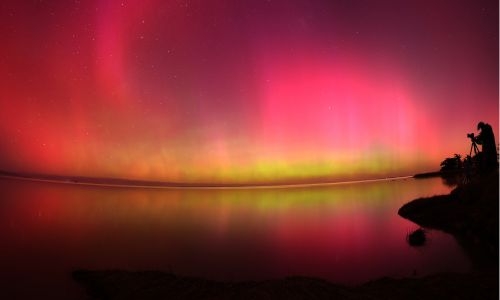First 'extreme' solar storm in 20 years brings spectacular auroras
AFP | Paris, France
The Daily Tribune – www.newsofbahrain.com
Earth was set to be struck by more powerful solar storms yesterday, a day after the most extreme events in two decades triggered spectacular celestial light shows from Tasmania to Britain and threatened possible disruptions to satellites and power grids.
The first of several coronal mass ejections (CMEs) -- expulsions of plasma and magnetic fields from the Sun -- came just after 1600 GMT Friday, according to the US-based National Oceanic and Atmospheric Administration (NOAA)'s Space Weather Prediction Center.
It was later upgraded to an "extreme" geomagnetic storm -- the first since the "Halloween Storms" of October 2003 caused blackouts in Sweden and damaged power infrastructure in South Africa.
Social media lit up with people posting pictures of auroras from northern Europe and Australasia.
"We've just woken the kids to go watch the Northern Lights in the back garden! Clearly visible with the naked eye," Iain Mansfield in Hertford, England, told AFP.
That sense of wonder was shared in Australia's island state of Tasmania.
The excitement spread across Europe and North America, from Mont Saint-Michel on the French coast to Payette, Idaho, where the sky shimmered with green light above the western US states.
The NOAA, in a Saturday update, said "storming of varying intensity" will persist through at least Sunday.
"The threat of additional strong flares and CMEs will remain until the large and magnetically complex sunspot cluster rotates out of view over the next several days," it said.
"There have been reports of power grid irregularities and degradation to high-frequency communications and GPS," it added.
‘Go outside tonight and look’ Authorities notified satellite operators, airlines and the power grid to take precautionary steps for potential disruptions caused by changes to Earth’s magnetic field.
Elon Musk, whose Starlink satellite internet operator has some 5,000 satellites in low Earth orbit, described the solar storm as the “biggest in a long time.”
“Starlink satellites are under a lot of pressure, but holding up so far,” Musk posted on his X platform.
China ’s National Center for Space Weather issued a “red alert” Saturday morning warning the storm is expected to continue through out the weekend and will impact communications and navigation in most areas of the country, state news agency Xinhua reported.
Unlike solar flares, which travel at the speed of light and reach Earth in around eight minutes, CMEs travel at a more sedate pace, with officials putting the current average at 800 kilometres (500 miles) per second.
The CMEs emanated from a massive sunspot cluster that is 17 times wider than our planet. The Sun is approaching the peak of an 11-year cycle that brings heightened activity.
Related Posts

